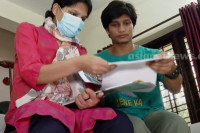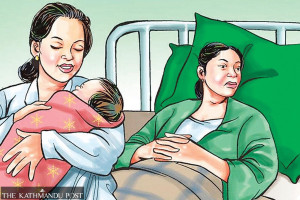Health
JE claims 34 lives, 76 percent of victims above 40 years
Experts say high mortality shows problems in service quality of health care. Vaccination plans stalled since September Gen Z protests.
Post Report
As many as 34 people died and 175 others were infected with the Japanese encephalitis (JE) virus that has spread to 117 local units of 45 districts of Nepal since June.
The number of deaths, death rate, and infections are at their highest in recent years, which immunisation experts say is alarming.
“One third death, one third disability and one third cure is a thing of the past,” said Dr Shyam Raj Upreti, former director general at the Department of Health Services. “High mortality and morbidity rate indicates not only rapid surge in the deadly virus but also serious problems in the quality of healthcare services.”
JE is a viral brain infection, endemic to Asia and parts of the Western Pacific. According to the World Health Organisation, it is a mosquito-borne flavivirus belonging to the same family as dengue, Zika, yellow fever, and West Nile viruses. The virus kills a third of those who fall ill and leaves up to a half of those who survive with severe life-long disabilities, according to the UN health body.
Last year, 23 people succumbed to JE, including one in Kathmandu Valley, and over 80 people were infected.
New data from the Immunisation Section of the Family Welfare Division under the Department of Health Services shows that the majority—76 percent of JE related deaths occurred in people above 40 years of age. The deadly virus first appeared in eastern Nepal in June and gradually spread to the western parts of the country. Of the 45 affected districts, 23 are hill districts.
Lumbini province reported 11 JE deaths and 55 infections, the highest in the country, followed by Gandaki province with five deaths and 34 infections, and Bagmati province with eight deaths and 24 infections.
Similarly, Koshi province reported four deaths and 23 infections, Madhesh province three deaths and 17 infections, Sudurpaschim province two deaths and 15 infections, and Karnali province one death and seven infections.
The number of reported cases could be just the tip of the iceberg, as tests are usually carried out only on hospitalised patients with severe conditions, officials say.
Seventy percent of lab-confirmed JE cases have been detected in those above 15 years of age.
Doctors say complications from JE infection could cause permanent injuries to the brain and the nervous system. As there is no specific cure, treatment focuses on managing symptoms. However, safe and effective vaccines have been developed to prevent infection.
Health officials said that their attempts to persuade development partners, including the World Health Organisation, to support a mass JE vaccination campaign have not succeeded in the past year.
“Discussions were ongoing to inoculate vulnerable populations with JE vaccine in the past,” an official at the Health Ministry said, asking not to be named, as he is not authorised to speak to the media. “But after the devastation caused by Gen Z protests and change in the government leadership, neither any discussion nor progress has been made in this issue.”
The youth-led anti-corruption protests on September 8 and 9 caused unprecedented damage to public and private property in Nepal and forced out the KP Oli-led coalition government. Seventy-six people, mostly youths, were killed.
Public health experts say the current interim government must prioritise vaccination for vulnerable populations if it cannot inoculate everyone at once.
“Saving the lives is the primary duty of any government,” said Upreti. “Pig farmers and those involved in agriculture have been especially affected and should be prioritised for vaccination.”
In 2005, JE killed nearly 2,000 people in Nepal—mostly children in districts in the southern plains. Nepal started administering the vaccine in 2006, eight years before the World Health Organisation officially issued prequalification certification, due to high rates of infection and deaths from the virus at the time.
In the first phase, all populations of the highly affected four districts—Banke, Bardiya, Dang, and Kailali—were vaccinated. Later, the programme was expanded to 19 other affected districts, targeting children under 15.
The government integrated the JE vaccine into routine immunisation in 2015. Even then, people continue to die, and dozens get infected every year.
The JE virus is transmitted to humans through the bite of infected Culex mosquitoes. Pigs and ducks are considered natural reservoirs of the virus.
Doctors advise avoiding mosquito bites, such as by using mosquito repellents, wearing long-sleeved clothes, and getting vaccinated if one lives in or travels to disease-endemic areas. They also stress the importance of awareness and timely treatment to prevent infections and deaths.
An estimated 12.5 million people are thought to be at high risk of JE infection in Nepal.




 10.12°C Kathmandu
10.12°C Kathmandu













